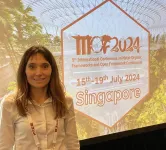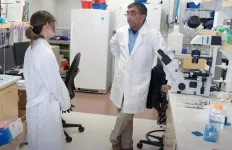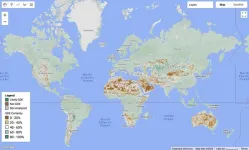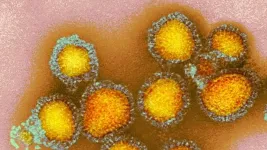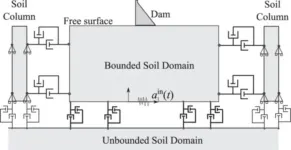(Press-News.org) A major obstacle for net zero technologies in combatting climate change is bridging the gap between fundamental research and its application in the real world.
This gap, sometimes referred to as ‘the valley of death’, is common in the field of carbon capture, where novel materials are used to remove carbon dioxide from flue gasses produced by industrial processes. This prevents carbon from entering the atmosphere, helping to mitigate the effects of climate change.
Chemists have proposed and synthesised thousands of novel materials, such as metal-organic frameworks, with the specific purpose of capturing as much carbon dioxide as possible. But while results may look promising in a lab setting, it is difficult to know how effective these materials will perform in actual scenarios. As a result, chances are slim that any will ever cross the valley of death.
Now, a team of scientists from Heriot-Watt University is behind a pioneering platform named PrISMa (Process-Informed design of tailor-made Sorbent Materials) which uses advanced simulations and machine learning to find the most cost-effective and sustainable material-capture process combinations prior to implementation.
The platform and its associated research have been published today (July 17) in the internationally renowned journal, Nature.
Professor Susana Garcia led the study and is the project coordinator for PrISMa. She is also the Associate Director of Carbon Capture, Utilisation and Storage (CCUS) at the Research Centre for Carbon Solutions (RCCS) at Heriot-Watt University in Edinburgh, Scotland.
She explains: “Over the past decade, there has been a huge amount of effort devoted to identifying promising materials capable of capturing CO2.
“Chemists have proposed thousands of novel porous materials, but we did not have the tools to quickly evaluate if any materials are promising for a carbon capture process. Evaluating such materials requires a lot of experimental data and detailed knowledge of the capture process. And a careful evaluation of the economics and life-cycle assessment of the process.
“We cannot expect chemists to have all that knowledge. Here is where PrISMa can make a huge difference. The PrISMa platform is a modelling tool that integrates different aspects of carbon capture, including materials, process design, economic analysis, and life cycle assessment. We use quantum chemistry, molecular simulation, and Machine Learning to predict, for new materials, all the data that is needed to design a process. Alternatively, we can use the experimental data from materials synthesised in a lab. The platform then evaluated their performance in over 60 different case studies from around the world.”
Professor Garcia continues: “This innovative approach accelerates the discovery of top-performing materials for carbon capture, surpassing traditional trial-and-error methods. The platform can also inform the different stakeholders by providing engineers with options to identify economically and environmentally challenging factors in the design phase of optimal capture technologies, molecular design targets for chemists and environmental hotspots for materials, local integration benefits for CO2 producers, and the best locations for investors.”
PrISMa is already yielding impressive results with the platform having been used to accurately simulate the implementation of carbon capture technologies in cement plants located in different regions of the world. It found suitable materials for each location, cutting costs by half when compared with previous technologies.
PrISMa also offers an interactive tool that allows users to explore the potential of over 1,200 materials for carbon capture applications.
"Identifying more top-performing carbon capture materials increases the likelihood of advancing some of them to the next Technological Readiness Level," continues Professor Garcia.
Fergus Mcilwaine, a PhD student leading the Machine Learning activities in Professor Garcia's team, added: " Screening such a large number of materials requires huge amounts of computational time. We developed a Machine Learning model that significantly accelerates this process, allowing us to discover cost-effective materials from enormous chemical design spaces."
PrISMa has been led by Heriot-Watt University in partnership with scientists from the Swiss Federal Institute of Technology Lausanne (EPFL) and ETH Zurich, Lawrence Berkeley National Laboratory and the University of California Berkeley in the US, and the Institut des Matériaux Poreux de Paris in France. The project has received funding from the ACT Programme, the Grantham Foundation for the Protection of the Environment and the Industrial Decarbonisation Research and Innovation Centre (IDRIC).
Professor Garcia concluded: “This study highlights the need to follow a holistic approach when evaluating technologies to achieve our net-zero targets. The platform speeds up materials discovery for carbon capture applications and focuses Research and Development efforts towards achievable performance targets at scale.
“The tool can help tremendously our current industrial decarbonisation efforts. It can play a key role in informing investment strategies and policy decisions on more sustainable and cost-effective carbon-capture solutions.”
END
Genomes can now be entrusted to store information about a variety of transient biological events inside of living cells, as they happen, like a flight recorder collecting data from an aircraft.
“Our method, which goes by the acronym ENGRAM, aims to turn cells into their own historians,” said Dr. Jay Shendure, a professor of genome sciences at the University of Washington School of Medicine and scientific director of the Brotman Baty Institute for Precision Medicine. Shendure led the effort, together with Wei Chen, a former graduate student, and Junhong Choi, a former postdoctoral fellow. Junhong ...
The USC Schaeffer Institute for Public Policy & Government Service announced a new initiative today that leverages behavioral science to create more effective public policy.
The Behavioral Science & Policy Initiative at the USC Schaeffer Institute will conduct research to understand people’s beliefs and behaviors to create policies and communication that better fit people’s needs. The initiative will focus on policy topics such as climate change, health, and food insecurity.
“We want to help policymakers make a difference,” said Wändi Bruine de Bruin, the initiative’s ...
(Santa Barbara, Calif.) — Where hidden water tables meet the Earth’s surface, life can thrive even in the driest locations. Offering refuge during times of drought, shallow groundwater aquifers act like water savings accounts that can support ecosystems with the moisture required to survive, even as precipitation dwindles. As climate change and human water use rapidly deplete groundwater levels around the world, scientists and policy makers need better data for where these groundwater-dependent ecosystems exist.
Now, a new study maps ...
– By Michael Matz
Researchers at the Department of Energy’s Lawrence Berkeley National Laboratory (Berkeley Lab) and several collaborating institutions have successfully demonstrated an innovative approach to find breakthrough materials for quantum applications. The approach uses rapid computing methods to predict the properties of hundreds of materials, identifying short lists of the most promising ones. Then, precise fabrication methods are used to make the short-list materials and further ...
Most influenza viruses enter human or animal cells through specific pathways on the cells’ surface. Researchers at the University of Zurich have now discovered that certain human flu viruses and avian flu viruses can also use a second entry pathway, a protein complex of the immune system, to infect cells. This ability helps the viruses infect different species – and potentially jump between animals and humans.
The majority of type A influenza viruses circulating in birds and pigs aren’t normally a health ...
In a significant advancement for geotechnical engineering, a refined space-time finite element method (v-ST/FEM) has been introduced to tackle the complex dynamics of soil-structure interaction during seismic events. This new approach allows for more accurate simulations of the response of earth structures to earthquake vibrations, marking a crucial step in improving infrastructure resilience against natural disasters.
Designing structures like dams, tunnels, and embankments to withstand transient loads from sources such as earthquakes, high-speed trains, and explosions requires robust dynamic soil-structure interaction (SSI) analysis. Traditional methods often fall short in handling ...
This study was led by Dr. Guanghua Huang (School of Life Sciences, Fudan University). The team discovered that the conserved Vps21 signaling pathway plays critical roles in the regulation of white-opaque switching and mating in Candida albicans, a major human fungal pathogen.
Candida albicans is able to cause cutaneous diseases as well as life-threatening systemic infections in humans. It has multiple cellular morphologies and can undergo transitions among different morphologies to adapt to environmental changes. White-opaque transitions represent a typical morphological phenotypic switching system ...
A new study shows that about two percent of the population develop autoantibodies against type 1 interferons, mostly later in life. This makes individuals more susceptible to viral diseases like COVID-19. The study, conducted by UZH researchers together with a USZ team, is based on an analysis of a large collection of historical blood samples.
Virus infections trigger the cells of the immune system to release type 1 interferons. These proteins act as early messengers that warn uninfected cells and tissues that a virus is spreading. This allows ...
Chronic cholestasis, defined as the impairment of bile acid formation and/or flow persisting for more than six months, encompasses a broad spectrum of hepatobiliary disorders, both heritable and acquired. This review focuses on heritable causes of chronic cholestasis, which, although less common, present significant clinical challenges. Heritable chronic cholestatic liver diseases are typically diagnosed in childhood, but many cases present and persist into adulthood. This review aims to highlight the genetics, clinical pathophysiology, presentation, ...
COLUMBUS, Ohio – Pet cats may be excellent animal models for the study of obesity origins and treatment in humans, a new study of feline gut microbes suggests – and both species would likely get healthier in the research process, scientists say.
Veterinary researchers analyzed fecal samples from fat cats as the animals lost and maintained weight over the course of four dietary changes, including strict calorie reduction. The team found that food-related changes to the cats’ gut microbiome – the assortment ...
